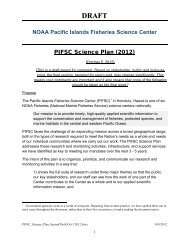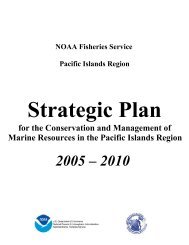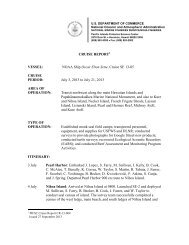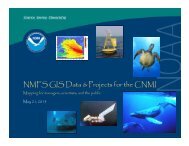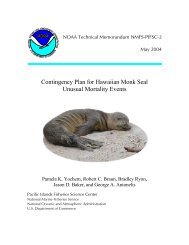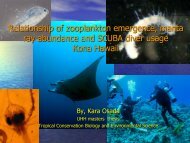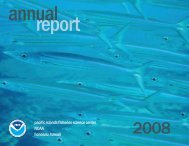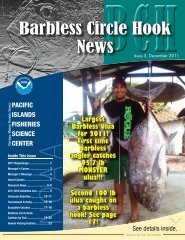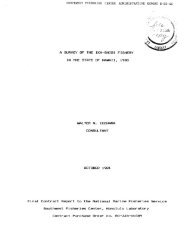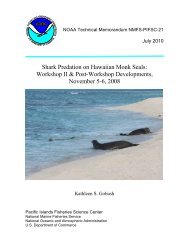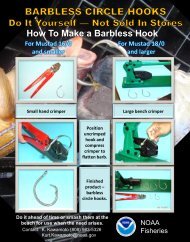Tibbatts B Fisheries Resources of Guam. Mariana Archipelago ...
Tibbatts B Fisheries Resources of Guam. Mariana Archipelago ...
Tibbatts B Fisheries Resources of Guam. Mariana Archipelago ...
Create successful ePaper yourself
Turn your PDF publications into a flip-book with our unique Google optimized e-Paper software.
<strong>Fisheries</strong> <strong>Resources</strong> <strong>of</strong> <strong>Guam</strong><br />
Department <strong>of</strong> Agriculture Division <strong>of</strong><br />
Aquatic and Wildlife <strong>Resources</strong><br />
(DAWR)
Marine <strong>Resources</strong> <strong>of</strong> <strong>Guam</strong><br />
• Fishes‐1019<br />
• Echinoderms‐196<br />
• Crustaceans‐663<br />
• Bivalves‐339<br />
• Sl Scleractinian tii Corals‐377<br />
• Macroalgae‐237<br />
• 228 km2 <strong>of</strong> coral reef area (108 km2 in <strong>Guam</strong>’s<br />
EEZ, 110 km2 in federal EEZ)
Island<br />
Land<br />
Area<br />
(km 2 )<br />
Reef<br />
Area<br />
(km 2 )<br />
Population<br />
Ratio<br />
(# <strong>of</strong> people/<br />
km 2 reef)<br />
<strong>Guam</strong> 550 228 163,000 714.9<br />
CNMI 459
<strong>Fisheries</strong> on <strong>Guam</strong><br />
• Data has been collected since the 1960s.<br />
• Standardized format since 1982 for boat<br />
based fishery and 1985 for shore based<br />
• More than 400 species in the DAWR catch<br />
data base.
Fishing on <strong>Guam</strong><br />
• Fishing on <strong>Guam</strong> can be divided into two<br />
broad categories:<br />
• Boat based‐ target pelagic species as well as<br />
coral reef and deep bottom species<br />
• Shore based‐ Target coral reef species and a<br />
small component <strong>of</strong> freshwater species.<br />
• 35% <strong>of</strong> residents consider themselves to be<br />
fishermen.
Boat Based Pelagic Fishery<br />
• Primarily smaller than 34 feet.<br />
• Trolling generally day trips, 6152 trips averaging<br />
around 5.5 hours in 2012<br />
• An estimated 382 vessels landed 521,680 pounds <strong>of</strong><br />
pelagic fishes. (31 year average approximately 590,000<br />
pounds per year)<br />
• Pl Pelagic catch thon <strong>Guam</strong> composed primarily il <strong>of</strong> 5<br />
species: Skipjack tuna, Mahi mahi, Wahoo, Marlin, and<br />
Yellow Fin Tuna.<br />
• Usually around a dozen less common species as well<br />
e.g. sailfish, sharks, rainbow runner, other types <strong>of</strong><br />
tuna
Boat Based Coral Reef Fishery<br />
• Bottom fishing, jigging, jgg g, surround net, and spear<br />
fishing, account for more than 90% <strong>of</strong> take.<br />
• Jigging and surround nets used for atulai (Big<br />
eyed Scad)<br />
• Emperors, snappers, groupers, jacks, surgeon<br />
fish, parrot fish, rabbit fish primary components<br />
<strong>of</strong> the bottom and spear fisheries<br />
• Shallow bottom boat based fishing averages<br />
about 50,000000 pounds annually<br />
• In 2012, around 2000 bottom fishing trips were<br />
made, with an average length <strong>of</strong> about 6 hours
Boat Based Deep Bottom Fishery<br />
• Primarily at <strong>of</strong>fshore banks<br />
• Snappers, groupers are primary components<br />
<strong>of</strong> this fishery.<br />
• Deep bottom fishery averages over 40,000<br />
pounds annually.
Shore Based Fishery<br />
• primarily hook and line fishing, talaya (throw<br />
net), tekin (gill net), spear fishing, other net<br />
types, and gleaning account for more than<br />
90% <strong>of</strong> shore based catch.<br />
• Acanthurids, Siganids, Mullids, Carangids<br />
(including atulai), Scarids, Lethrinids, and<br />
Mugilids account for nearly 90% <strong>of</strong> shore<br />
based catch in 2012.
Pelagic fisheries<br />
• Costs<br />
• Impacts from commercial fisheries<br />
• Potential ilimpacts from climate change and<br />
other meteorological phenomena<br />
• Spawning data. Temporal/geographical
Coral Reef <strong>Fisheries</strong><br />
• Connectivity<br />
• Increased fishing pressure<br />
• Habitat loss and degradation. d • Climate change.



